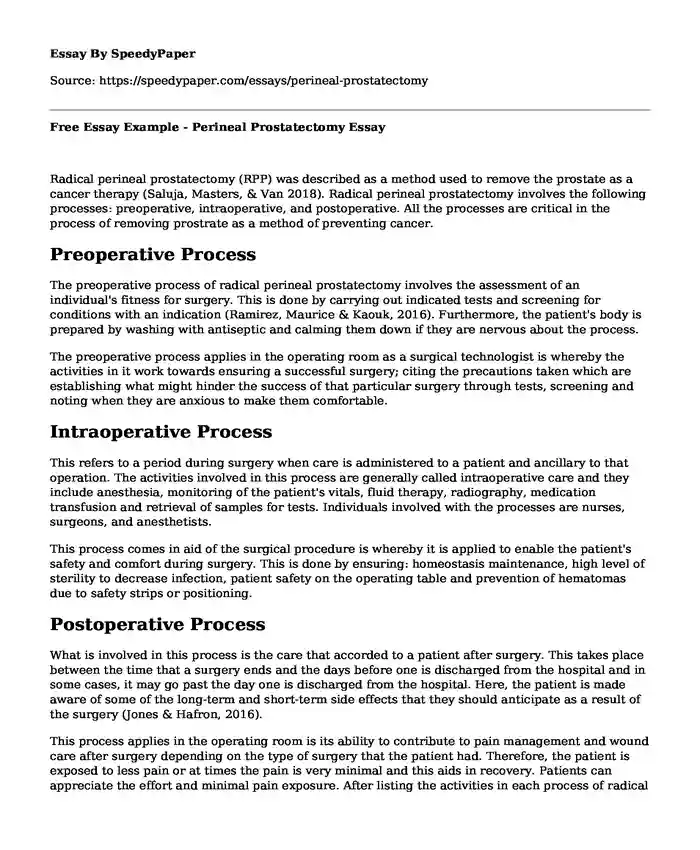Radical perineal prostatectomy (RPP) was described as a method used to remove the prostate as a cancer therapy (Saluja, Masters, & Van 2018). Radical perineal prostatectomy involves the following processes: preoperative, intraoperative, and postoperative. All the processes are critical in the process of removing prostrate as a method of preventing cancer.
Preoperative Process
The preoperative process of radical perineal prostatectomy involves the assessment of an individual's fitness for surgery. This is done by carrying out indicated tests and screening for conditions with an indication (Ramirez, Maurice & Kaouk, 2016). Furthermore, the patient's body is prepared by washing with antiseptic and calming them down if they are nervous about the process.
The preoperative process applies in the operating room as a surgical technologist is whereby the activities in it work towards ensuring a successful surgery; citing the precautions taken which are establishing what might hinder the success of that particular surgery through tests, screening and noting when they are anxious to make them comfortable.
Intraoperative Process
This refers to a period during surgery when care is administered to a patient and ancillary to that operation. The activities involved in this process are generally called intraoperative care and they include anesthesia, monitoring of the patient's vitals, fluid therapy, radiography, medication transfusion and retrieval of samples for tests. Individuals involved with the processes are nurses, surgeons, and anesthetists.
This process comes in aid of the surgical procedure is whereby it is applied to enable the patient's safety and comfort during surgery. This is done by ensuring: homeostasis maintenance, high level of sterility to decrease infection, patient safety on the operating table and prevention of hematomas due to safety strips or positioning.
Postoperative Process
What is involved in this process is the care that accorded to a patient after surgery. This takes place between the time that a surgery ends and the days before one is discharged from the hospital and in some cases, it may go past the day one is discharged from the hospital. Here, the patient is made aware of some of the long-term and short-term side effects that they should anticipate as a result of the surgery (Jones & Hafron, 2016).
This process applies in the operating room is its ability to contribute to pain management and wound care after surgery depending on the type of surgery that the patient had. Therefore, the patient is exposed to less pain or at times the pain is very minimal and this aids in recovery. Patients can appreciate the effort and minimal pain exposure. After listing the activities in each process of radical perineal prostatectomy, it is safe to say that in an actual operating room; the preoperative process would be used to establish if the prostate cancer has spread beyond the prostate by comparing biopsy results and PSA levels. If it does not work then there will be the need for CT scans, MRI scans or ultrasound.
Intraoperative comes in during radical perineal prostate when there is need to care for the patient during this procedure, for example, a surgeon using a robotic system of surgical tools which has a screen that shows the functioning of the patient's body during surgery to ensure their patient's safety or choosing advanced methods of incision such as robot-assisted laparoscopic prostatectomy to evade more complications. The postoperative process applies during the explanation of complications of this process.
References
Jones, P. M., & Hafron, J. (2016). Diagnosis and Management of Localized Prostate Cancer. In The Nurse Practitioner in Urology (pp. 295-307). Springer, Cham.
Ramirez, D., Maurice, M. J., & Kaouk, J. H. (2016). Robotic perineal radical prostatectomy and pelvic lymph node dissection using a purposebuilt singleport robotic platform. BJU international, 118(5), 829-833.
Saluja, M., Masters, J., & Van Rij, S. (2018). Open simple prostatectomy. In The Big Prostate (pp. 143-152). Springer, Cham.
Cite this page
Free Essay Example - Perineal Prostatectomy. (2023, Feb 22). Retrieved from https://speedypaper.com/essays/perineal-prostatectomy
Request Removal
If you are the original author of this essay and no longer wish to have it published on the SpeedyPaper website, please click below to request its removal:
- Social Mobility in the UK - Free Essay in Sociology
- Save the Ocean - Free Essay with The Presentation Analysis
- Essay Sample on the Fictional Story on Lwanda Magere
- Measures of Democracy and Dictatorship - Political Science Essay Sample
- Business Admire - Business Essay Example for Your Inspiration
- YouTube Interface Evaluation - Paper Example
- Free Essay Example: Importance of Responsibility in Military
Popular categories





